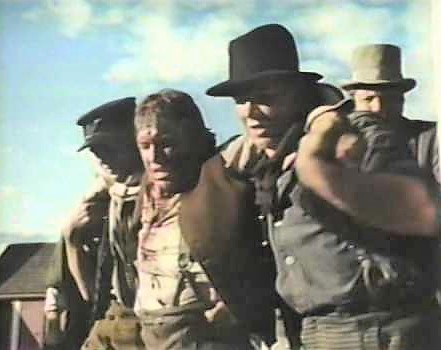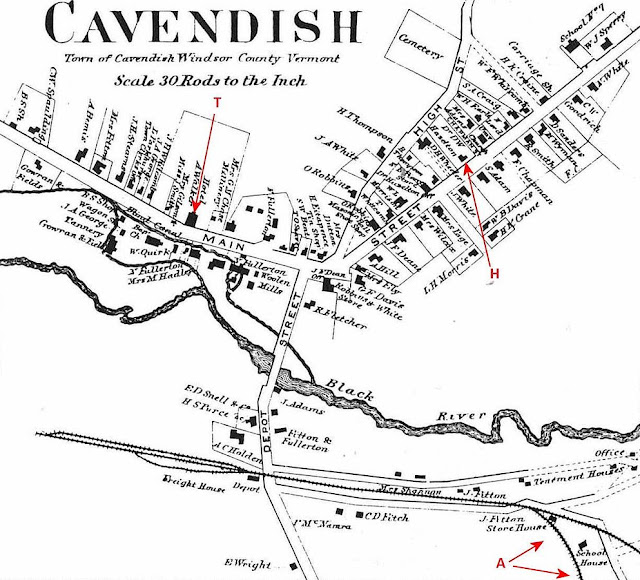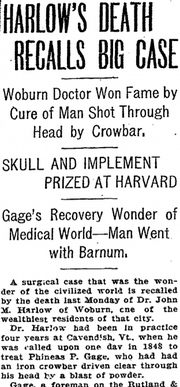I suppose the most unhelpful way to measure the experience of Phineas P. Gage was with phrenology. Practitioners, like the American Orsen Squire Fowler, would run their fingers over the bumps on your head and divine your occupation, and character flaws. But as Fowler acknowledged, "....phrenology is either fundamentally true or else untrue..." - a statement, which standing alone, is undoubtedly true. But the ultimate disproof of phrenology would be provided by the words, "Phineas Gage".
Phineas was originally an Egyptian title, meaning a dark or bronze skinned oracle. He first appears in the Old Testament (Numbers 25, verses 7-8), as a priest's son who spies the Hebrew prince Zimri entering the Tabernacle with a Midianite woman. In a fit of offended religious passion, Phineas runs them both through with a spear. For this double murder, Moses rewards Phineas. Not something Jesus would have done, certainly.
His family name was English. Almost half of all modern English words were adopted from the French spoken in Normandy in 1066. This Old French was mostly based on the everyday language spoken by Roman soldiers. In their Vulgate Latin a "jalle" was a measure of liquid, equal to a gallon, and a "jalgium" was the stick or rod inserted into an amphora to measure how much wine was left. After the Great Vowel Shift" at the end of the Middle Ages it became "gaunger" and was shortened to "gauge". Thus a gauge is a standard of measurement, or a tool used to measure. And by a happy coincidence, those two words describe the Phineas Gage perfectly - an oracle of measurement. If unwilling.
In 1823 Phineas P. Gage was born in the southern New Hampshire village of Lebanon. He grew into a strikingly handsome young man, and a natural leader. At 24 years of age he became a "Navvie" for the Burlington and Rutland Railroad. The term was borrowed from canal builders who plotted their work cross-country by compass. Inland navigators they were called. Phineas quickly rose to the level of foreman, and was entrusted with the dangerous job of blasting through the hard New England granite to ensure a level road bed for the rails.
In 1825 Englishman George Stephenson's locomotive "The Rocket" took less than two hours to haul 36 wagons of coal nine miles to the docks on the River Tees. His steam locomotive was not only a revolution in speed, but also reduced transportation costs by two thirds. George had set his new rails four feet eight and one-half inches apart because that was the "gauge", or measure of the old rails, used when the wagons were pulled by horses.
The next generation of rail moguls literally followed in Stephenson's tracks. Of course, George had since improved on his design, adding six inches width for increased stability. But rather than replace the 1,200 miles of substandard rails already in use, the royal commission of 1845 decreed that four feet eight and one-half inches would be the "Standard Gauge" for Britain, and eventually most of the rest of the world. That same year, 1845, George Stephenson, "Father of the railways" married for the third time. And shortly thereafter he died.
Three years later, on Wednesday 13 September, 1848, a Rutland and Burlington Railroad construction crew, headed by the 25 year-old foreman Phineas P. Gage, was preparing a new road bed outside of the little mill town of Cavendish, Vermont. Each member had a simple job, which is to say their collective task was a technically complicated jigsaw puzzle of mundane occupations, which when combined in a specific order, changed the world.
In this case, an engineer would determine where rock was to be removed. Other men would drill a hole into the rock. Phineas Gage would then pour a measure of black powder into the hole. Then he would pour a measure of sand on top of the powder, and firmly tamp it down. Then Phineas would insert a fuse through the sand into the powder. Then he would repeatedly drop a 35 pound, three and a-half foot long iron tamping rod into the hole to compact the charge. Finally, Phineas would light the fuse.
After the resulting explosion, workers would remove the broken rock while the engineer determined where the next charge would be placed.Toward the end of a had day's work, at just about 4:30 P.M., Phineas ordered his weary drilling team to take cover yet again.
Again he poured black powder into the drill hole, but in haste this time he forgot to add the sand. So when he shoved down the iron tamping rod, it sparked against the granite. And without the insulating sand, that set off the black powder.
There was a sharp loud crack. In something less than one second, the 35 pound rod was driven out of the hole, penetrating just below Gage's left cheek bone, destroying his left eye, plowing through his brain and blasting out the top of his skull.
The tamping rod landed 80 feet away, smeared in blood and brain matter.. The startled crew rushed to Phineas' assistance and found him awake and alert. (Below, A), but stunned.
With assistance Phineas clambered aboard an ox cart, and suffered the jarring forty-five minute long, three quarters of a mile ride back to his boarding house (above, T) in Cavendish. , where he waited on his front porch for an hour for the arrival of Dr. Edward Harlow.
"I first noticed the wound," wrote the good doctor, "before I alighted from my carriage, the pulsations of the brain being very distinct."
The doctor recorded that his patient had a pulse of 60, was breathing regularly and his pupils were reactive. He reported no pain. "Mr. Gage...was relating the manner in which he was injured to the bystanders," wrote Dr. Williams, ".(and then) got up and vomited; the effort...pressed out about half a teacupful of the brain, which fell upon the floor." After an initial exam, Dr. Williams escorted Gage to the local hospital. Over the next 24 hours Gage slipped into a coma, and his condition worsened until Williams lifted open the skull again and reported a "mold" growing on the brain. Williams wiped this away, and replaced the skull fragments. After that Phineas quickly improved, woke up and appeared to recover fully, except for the missing left eye.
The tamping rod had performed the first recorded frontal lobotomy in modern history on Phineas Gage's brain, disconnecting and destroying that part of his mind which dealt with "....future consequences... chooses between good and bad actions... (and) override(s) and suppress unacceptable social responses..." (Wikapedia - "Frontal Lobe"). Patients subjected to a frontal lobotomy do "...not respond to imaginary situations, rules, or plans for the future...pursued immediate gratification without regard for consequences.... (and) tended to be distracted by immediate stimuli" In addition, the patient displays "an empty euphoric effect...(and) can get unusually aggressive and tends to use puns a lot." In other words, Phineas Gage was a new gauge.
Despite occasional setbacks, Phineas was able to travel the thirty miles to his mother's home, in Lebanon, New Hampshire in time for Christmas, 1848. He returned to Cavendish in April of 1849, and Dr. Harlow noted "his physical health is good, and I am inclined to say he has recovered. Has no pain in (his) head, but says it has a queer feeling which he is not able to describe." Phineas' cryptic response brings to mind the 12 year old boy who was subjected to a frontal lobotomy over a century later, in 1960. He later told an interviewer, "I've always felt different - wondered if somethings missing from my soul."
Phineas never worked on railroads again. Briefly he tried selling his story via public speaking engagements, and displaying his rod. But handsome though he still was, that career never suited him. Despite rumors that he appeared in P.T. Barnum's museum in New York, there is no evidence he ever did. Instead, in 1851, he found a job at the Hanover Inn in Dartmouth, New Hampshire, as a stable hand and coach driver. Perhaps he found animals a better gauge of Gage than humans.
Then in 1854 he went to work for another stage line , this time in Valparaiso, Chile. He took with him his "constant companion", that iron tamping rod. Phineas held down his new job for seven years, far longer than you would expect from an unpredictable violent man. Those too are just rumors.
But one of the occasional side effects of a frontal lobotomy are seizures caused by scar tissue within the brain. And those now struck Phineas. In 1859 Phineas rejoined his mother, sister and her husband, who were now living in California. He got a job as a farm hand in Santa Clara County, at the southern end of San Francisco Bay. But the seizures got worse, and on 21 May, 1860, he died of what the doctors called complications of epilepsy, six months short of twelve years after he forgot to load the sand atop the black powder.
Phineas Gage died just as the American Civil War was exploding. Over the next four years the number of survivors with brain injuries multiplied.
Doctors now had patients and skulls aplenty to examine, and upon reflection they reached several conclusions. First, it was clear that the bumps on the top of the head were not denotative of anything going on inside the skull. Phrenology was bunk. But the disabilities of various head wound survivors was proof that different sections of the brain did perform different functions.
And third, the old adage that medicine is the search for profit after death, was confirmed when in 1866, Dr. Harlow convinced Phineas' sister and brother-in-law to disinter Phineas just long enough to chop off his head and ship it and the tamping rod back to Boston. Or so claimed the doctor. There Harlow used it as an exhibit in his second (and more colorful) paper. on his most famous patient. It was this version of events which made Phineas famous as the the man who reset the Gauge for brain injuries.Meanwhile the standard gauge of American railroads is still just four feet eight and one-half inches. I guess some things never change.
- 30 -

























